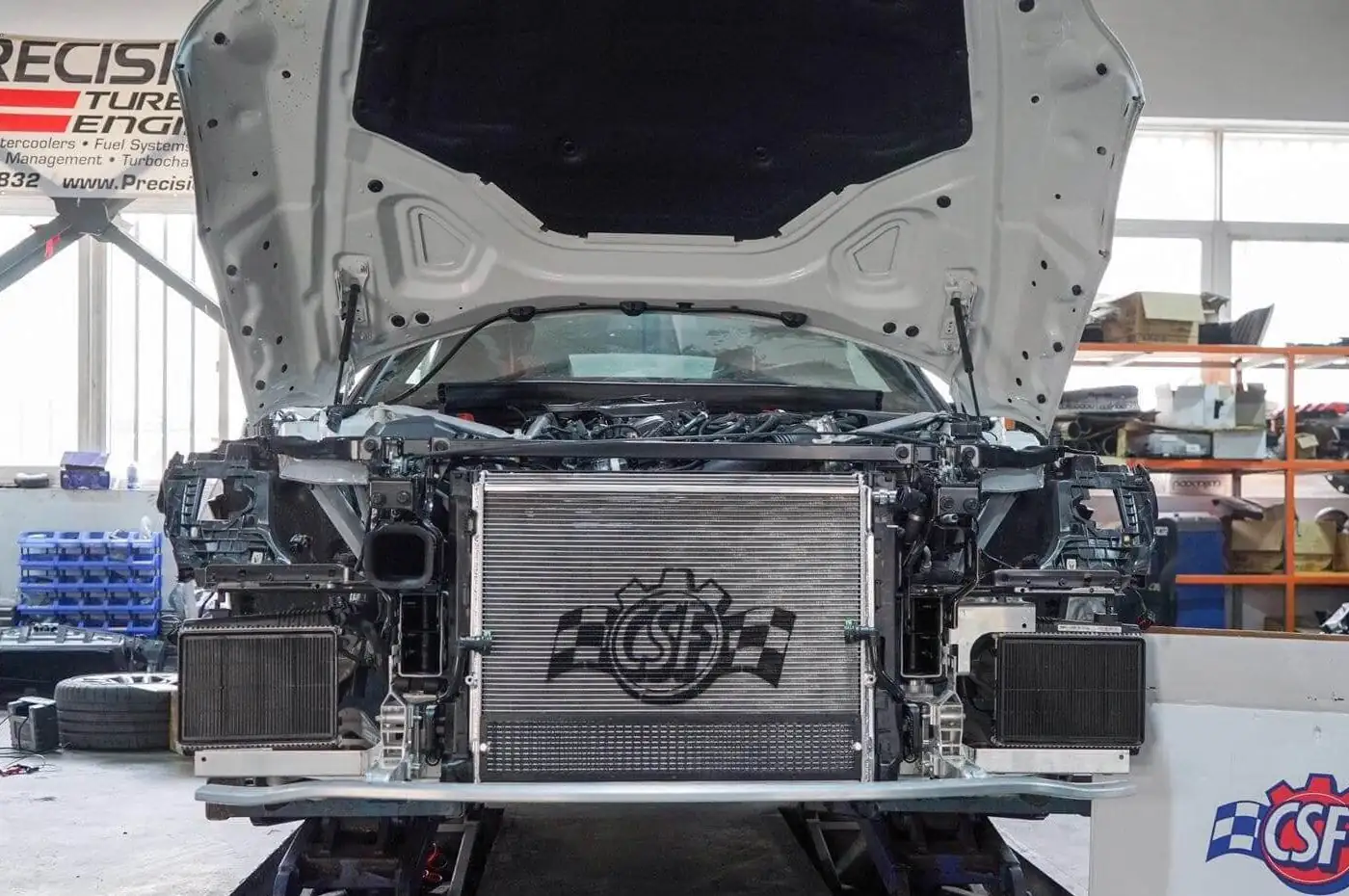After six months of development and testing with some of the best Supra tuners across the world, CSF is proud to announce its new high-performance all-aluminum charge cooler Front Mount Heat Exchanger upgrade for the A90/91 Toyota Supra (including some BMW G-Series fitment).
Vehicle Fitment:
2020+ Toyota GR Supra L4-2.0L Turbo (A90 A91 MKV MK5)
2018+ BMW G29 Z4 20i, 30i & M40i
2022+ BMW G42 2-Series (M240iX)
2018+ BMW G20 3-Series (320i, 330i, 330iX, M340i, M340iX)
2018+ G21 3-Series Touring (330i, 330iX, M340iX)
Features:
• Significantly Reduces Intake Air Temperature (IAT) for Maximum Performance (with Faster Heat Soak Recovery)
• Improves Air Flow to the Rest of the Cooling System for Both Lower Engine Water and Engine Oil Temperatures
• 2-Row, 42mm Ultra-High-Performance Core
• 6.5mm Tall Multi-Louvered Fin with CSF’s Exclusive B-Tube Technology
• CNC Machined Mounting Brackets and OEM Style “Quick Connect” Inlet/Outlet
• 100% All Aluminum TIG-Welded Construction
• Includes Rock Guard & Transmission Oil Cooler Mounting Kit (Industry Exclusive)
• “Drop-in” Fit
• 2-Year Limited Warranty
• Smooth Satin Finish
• Tested and Proven by CSF’s Global Network of R&D Partners, Including Leading Time Attack Teams, Tuners, and Turbo Kit Manufacturers
• Toyota OEM Part Number: 16400-WAA03
• BMW OEM Part Number: 17118666811
More Info:
Since the vehicle was released in 2019, enthusiasts have been looking for performance upgrades to unleash the full potential of the BMW-sourced B58 engine. It didn’t take long for weak points of the vehicle to become chatter across the internet, in Facebook groups, and at race tracks. One of the most apparent problems (and one that was quickly identified by anyone taking the car to a track day): the liquid-cooled charge air cooler system would quickly heat soak with no ability to recover. This would cause the intake air temperatures (IATs) to spike, resulting in the ECU cutting the power output of the vehicle, and eventually putting the car into limp mode.
CSF engineers witnessed the overheating issue first-hand as they were in attendance at the Global Time Attack Finals at Buttonwillow Raceway in November 2019. Several new heavily modified Supra racecars could barely go two or three laps in moderate ambient conditions without having the car go into limp mode, forcing drivers to take a cool down lap (or two), with some even coming into the pits to have their front mount heat exchangers sprayed down with cold water.
Since then, many aftermarket tuning companies have developed bolt-on performance upgrades, software tunes, as well as upgraded hybrid-turbos. Several companies have already pushed the limitations of the engine introducing fully upgraded turbo kits, with some pushing close to 800whp. The increase in horsepower also tremendously increases the heat generated from the engine, and puts further stress on an already flawed charge-air cooling system. When upgrading the vehicle’s power, the ECU can also start to pull timing and decrease the car’s power output – even just during spirited driving, not necessarily only on the track.
How the Charge Cooling System Works:
Because of CSF’s industry-leading reputation and deep knowledge of high-performance BMW cooling systems, its engineers immediately knew what had to be fixed in order to maximize and maintain consistent performance with the B58 engine. The engine is very similar to the S55 in the latest F8X M3/M4 – both feature a liquid-to-air charge cooler mounted on the top of the engine, along with a front mount heat exchanger (water radiator) that first cools the fluid that then cycles through the charge cooler, dissipating heat from the charge air before it enters the engine.

The difference is that the B58 liquid-to-air charge cooler is integrated into the intake manifold, rather than being a stand-alone unit that can be easily replaced (like in the F8X S55 variant). Because the charge cooler is built into the manifold, it’s extremely difficult to replace with a high-performance solution, with currently no aftermarket support available. The only solution to keeping intake air temperatures in control on a modified or track-ready Supra is to upgrade with the CSF Front Mount Heat Exchanger.
CSF’s Asian distributor and R&D partner, Unlimited Performance, took their stage-2 track-spec G29 BMW Z4, fitted with a prototype unit, to Tianma Raceway in Shanghai to help validate the performance of CSF’s B58 High-Performance Heat Exchanger. The report back from our development team was that IATs remained consistently 10-15°F (5.5-8.3°C) lower than with the stock heat exchanger installed, with maximum temperature delta proving a 40°F (22.2°C) reduction between the CSF and OEM cooler. Most importantly, the test Z4 was able to stay on the track longer due to maintained IATs, as well as the CSF Heat Exchanger helping improve airflow to the rest of the cooling system for both lower engine water and engine oil temperatures.
The CSF Advantage:
OEM 25mm 1-Row Core with Crimped Plastic Endtanks vs. CSF 42mm 2-Row Core with CSF’s Exclusive B-Tube Technology (100% TIG-Welded All-Aluminum Design)

Left: OEM rock guard & transmission cooler vs. Right: the CSF improved design, included billet transmission cooler mounts, and metal rock guard with improved airflow characteristics. CSF is the only company to include a rock guard and incorporate OEM transmission cooler mounting points for a true plug-and-play “drop-in” fit (minor trimming to OEM plastic transmission cooler mounting is required to accommodate the additional capacity design of the CSF High-Performance Heat Exchanger).
Before releasing this product, as CSF does with all new products, we made several prototypes and worked with some of the best race car teams, tuners, and experts in the industry to help with testing to ensure perfect fitment as well as extensive performance validation. Below is a summary of the five key partners that CSF chose to help with launching…



























